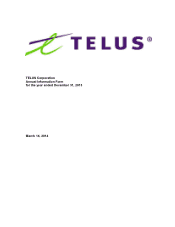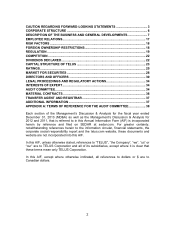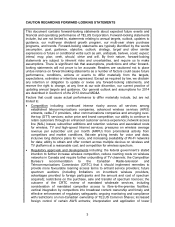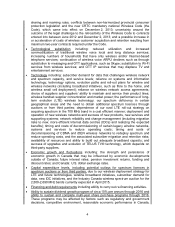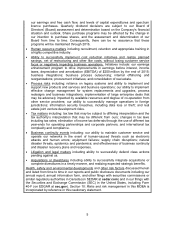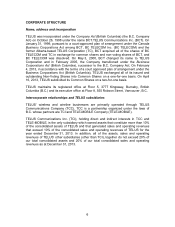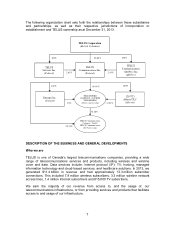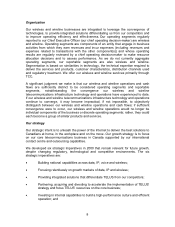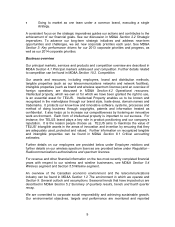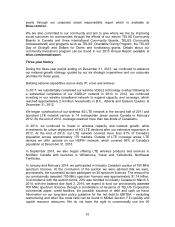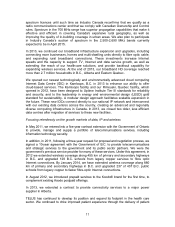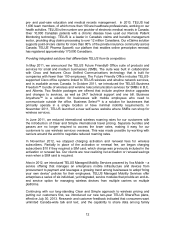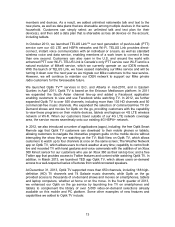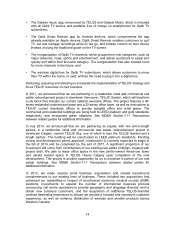Telus 2013 Annual Report Download - page 4
Download and view the complete annual report
Please find page 4 of the 2013 Telus annual report below. You can navigate through the pages in the report by either clicking on the pages listed below, or by using the keyword search tool below to find specific information within the annual report.
4
sharing and roaming rules; conflicts between non-harmonized provincial consumer
protection legislation and the new CRTC mandatory national Wireless Code (the
Code), which came into effect on December 2, 2013; uncertainty around the
outcome of the legal challenge to the retroactivity of the Wireless Code to contracts
entered into between June 2012 and December 2, 2013; and a possible increase in
or acceleration of costs of wireless customer acquisition and retention resulting from
maximum two-year contracts required under the Code.
Technological substitution including: reduced utilization and increased
commoditization of traditional wireline voice local and long distance services;
increasing numbers of households that have only wireless and/or Internet-based
telephone services; continuation of wireless voice ARPU declines such as through
substitution to messaging and OTT applications, such as Skype; substitution to Wi-Fi
services from wireless services; and OTT IP services that may displace TV and
entertainment services.
Technology including: subscriber demand for data that challenges wireless network
and spectrum capacity, and service levels; reliance on systems and information
technology; technology options, evolution paths and roll-out plans for wireline and
wireless networks (including broadband initiatives, such as fibre to the home, and
wireless small cell deployment); reliance on wireless network access agreements;
choice of suppliers and suppliers’ ability to maintain and service their product lines;
wireless handset supplier concentration and market power; the performance of long-
term evolution (LTE) wireless technology; our spectrum deficiency in certain
geographical areas and the need to obtain additional spectrum licences through
auctions or from third parties; dependence of our rural LTE roll-out strategy on
acquiring spectrum in the 700 MHz band in a cost efficient manner; deployment and
operation of new wireless networks and success of new products, new services and
supporting systems; network reliability and change management (including migration
risks to new, more efficient Internet data centres (IDCs) and realizing the expected
benefits); timing and costs of decommissioning of certain legacy wireline networks,
systems and services to reduce operating costs; timing and costs of
decommissioning of CDMA and iDEN wireless networks to redeploy spectrum and
reduce operating costs, and the associated subscriber migration and retention risks;
availability of resources and ability to build out adequate broadband capacity; and
success of upgrades and evolution of TELUS TV® technology, which depends on
third-party suppliers.
Economic growth and fluctuations including: the strength and persistence of
economic growth in Canada that may be influenced by economic developments
outside of Canada; future interest rates; pension investment returns, funding and
discount rates; and Canada: U.S. dollar exchange rates.
Capital expenditure levels, including potential outlays for spectrum licences in
spectrum auctions or from third parties, due to our wireless deployment strategy for
LTE and future technologies, wireline broadband initiatives, subscriber demand for
data, new IDC initiatives, and the Industry Canada wireless spectrum auction for the
2,500-2,690 MHz bands currently expected in April 2015.
Financing and debt requirements including ability to carry out re-financing activities.
Ability to sustain dividend growth program of circa 10% per annum through 2016 and
ability to sustain and complete multi-year share purchase programs through 2016.
These programs may be affected by factors such as regulatory and government
decisions, competitive environment, reasonable economic performance in Canada,

